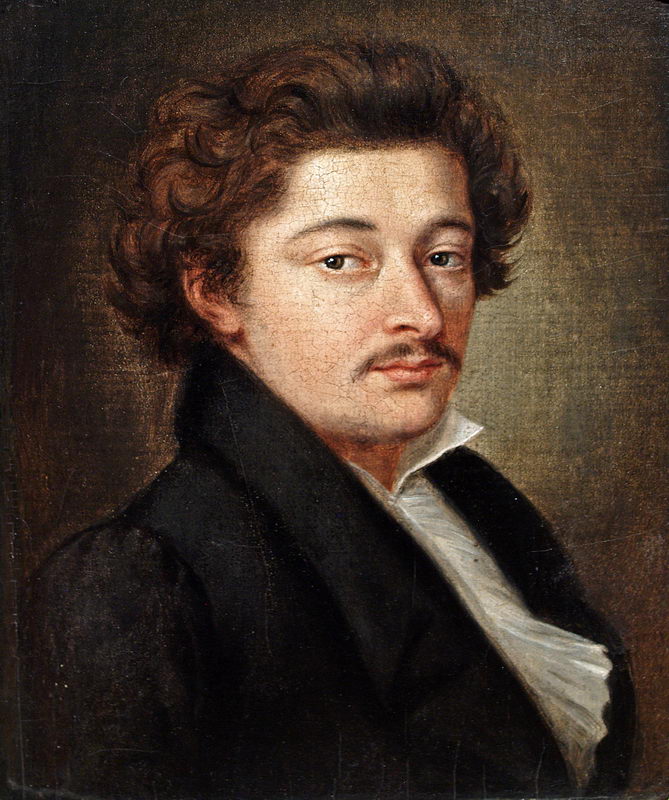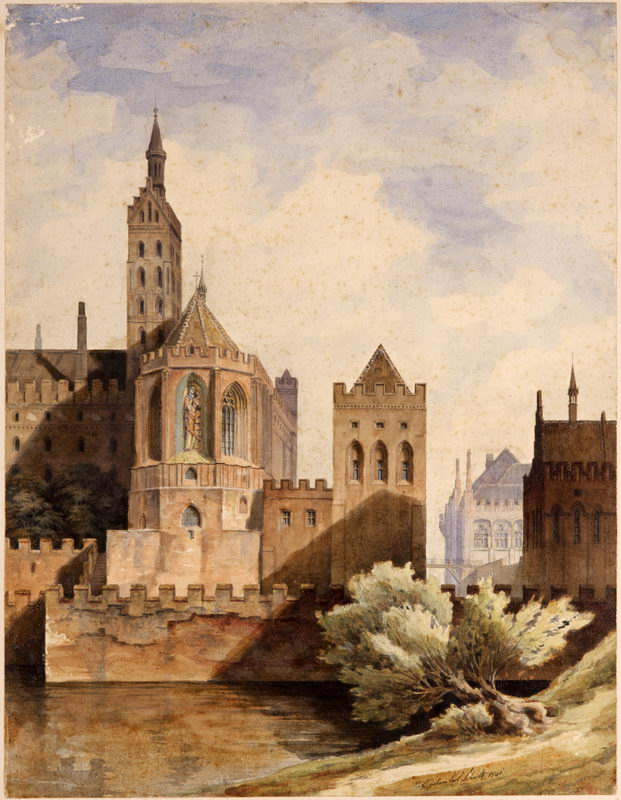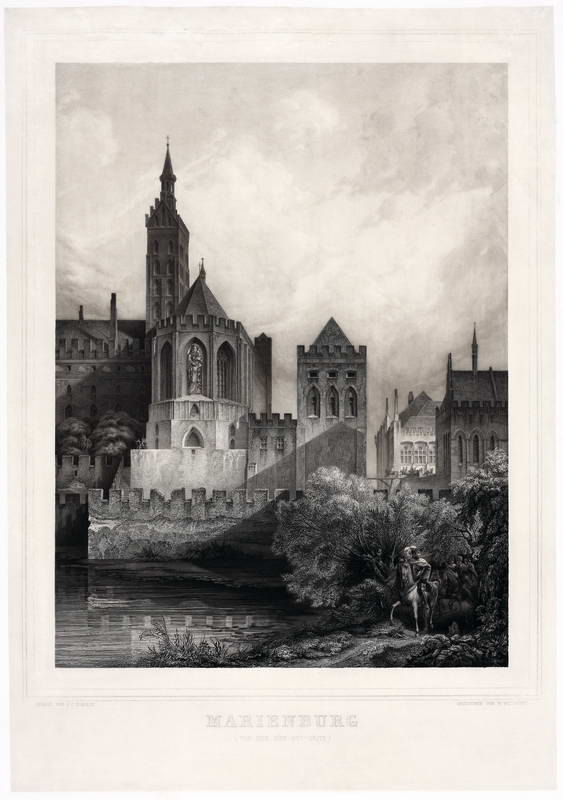Johann Carl Schultz, a painter and lover of Prussian antiquities, born in Gdańsk on May 5TH 1801 [Fig. 1] was the son of a wealthy merchant Martin Schultz and Jacobina Henrietta Röhr, daughter of the pastor of the Church of St. Bartholomew in the Old Town. From early childhood, he showed artistic talent and a love of old architecture. He received his first education in his hometown, in parish schools at St. John and the Blessed Virgin Mary and in the years 1818–1820 at the School of Fine Arts and Crafts under the supervision of its then director, painter of architectural monuments and art theorist, Johann Adam Breysig (1766–1831). After completing his education in his hometown, he studied at the Royal Academy of Fine Arts in Berlin for three years as a scholarship holder of the Peace Society (Friedensgesellschaft). Then he took a study tour of German countries, staying for a few months in Munich, and in the years 1824–1828 he stayed in Rome, also visiting the most interesting corners of the Apennine Peninsula and Sicily. Later, after four years in the capital of Prussia, he returned in 1832 to the town on the Motława River and took the position of director of the School of Fine Arts. He stayed here until his death on June 12, 1873, becoming involved in the social and artistic life of the city. The most famous piece in his work is a three-part album of picturesque views of old Gdańsk, made by the painter in the etching technique in the years 1855–1868. After the Second World War, it served as an “iconographic signpost” in the reconstruction of the city destroyed by fire from the Red Army. The artist was also a member of many scientific societies, the Academy of Fine Arts in Berlin and St. Petersburg, a collector; he co-founded the Gdańsk Art Society (Danziger Kunstverein) and the Association for the Preservation of Old Buildings and Monuments of Art in Gdańsk (Verein zur Erhaltung altertümlichen Bauwerke und Kunstdenkmäler Danzigs).
Between 1841 and 1853, after winning a competition with the Berlin vedutist Carl Ludwig Rundt for the development of views of the Malbork Castle for the planned graphic cycle, which is an artistic equivalent of Frickowski’s album Schloss Marienburg in Preussen. Nach seinen vorzüglichsten äussern und innern Ansichten dargestellt from 1799–1803, the artist created in watercolors and drawings sixteen castle vedutes. They showed in picturesque frames the real and half imaginary appearance of the Malbork castle in its external and internal views [fig. 4-6]. These works were inspired by President von Schön, who was one of the main advocates of the reconstruction of the Teutonic Knights stronghold and making it – the Prussian Westminster – a historical monument linking the history of the Teutonic Order and the Kingdom of Prussia. Some of them were sketches for oil paintings made for Frederick William IV and decorated his residences in Potsdam and Berlin. They were also reproduced for the needs of the then advertising in many graphic techniques, in the form of loose charts and book illustrations in the workshops of Leipzig, Konigsberg, Trieste, Dresden and Vienna. Of these, two engravings by Johann Wilhelm Friedrich Witthoeft (1816–1874) deserve special attention. They were to form part of a (eventually unrealized) graphic album showing the metamorphosis of the Malbork castle and the effects of a “romantic restoration”. These compositions presented the chancel of the castle church with a statue of the Madonna in the central niche and the facade of the Palace of the Grand Masters from the Nogat side [Fig. 7-8]. At the end of the 19th century, they were exhibited in the Corner Hall (former Meisters Gemach) on the main floor of the Grand Masters Palace and during the First World War they were moved to the upper basement, to the memorial room dedicated to the first restoration of the Malbork stronghold. Johann Carl Schultz himself also had two other copies in his private collections, in the Court of the Brotherhood of St. George.
(compiled by J. Lijka)

Il. 1. Matthäus Langus, Portrait of Johann Carl Schultz; oil on canvas; collection of the National Museum in Gdańsk (rep. known and unknown according to Johann Carl Schultz (1801–1873), exhibition catalog, ed. J. Lijka, Malbork 2009).

Il. 2. A large shield with the coat of arms of the great masters of the order on the entrance facade of the Middle Castle; lithography, paper; lit. G.R. Dahms sen., Ed. Winckelmann und Söhne, Berlin early 2nd half 19th century; collection of the Castle Museum in Malbork; inv. no. MZM / R / 76 (photo by L. Okoński).

Il. 3. Stone hand washing basin of the Association of Booksellers Association in Królewiec, carved by Kasch, Królewiec 1854, collection of the Castle Museum in Malbork (photo by J. Lijka).

Il. 4. Church of the Blessed Virgin Mary at the High Castle from the east; page of the 1st album of the Farbige Ansichten vom Schloss Marienburg von Prof. Schultz; Malbork – Gdańsk, 1841–1853 [1841]; cardboard, pencil, ink, watercolor; collection of the Castle Museum in Malbork; inv. no. MZM / DH / 765/1 (photo by L. Okoński).

Il. 6. Northern wing of the Middle Castle from the north-east; page of the 2nd album of Farbige Ansichten vom Schloss Marienburg von Prof. Schultz; Malbork – Gdańsk, 1841–1853 [1850]; cardboard, pencil, ink, watercolor (stuck on the left side, a movable narrow cardboard with a pencil drawing); collection of the Castle Museum in Malbork; inv. no. MZM / DH / 765/2 (photo L. Okoński).

Il. 8. View of the Palace of the Grand Masters from the west; mixed metal techniques; paper; drawing Johann Carl Schultz [1841], engraving Wilhelm Johann Friedrich Witthoeft (1816–1874), Berlin, 1840s. in.; collection of the Castle Museum in Malbork; inv. no. MZM / R / 810 (photo by L. Okoński).

Il. 5. High Hall in the Palace of the Grand Masters from the west; page of the 11th album of the Farbige Ansichten vom Schloss Marienburg von Prof. Schultz; Malbork – Gdańsk, 1841–1853 [1844]; cardboard, pencil, ink, watercolor; collection of the Castle Museum in Malbork; inv. no. MZM / DH / 765/11 (photo by Lech Okoński).

Il. 7. View of the Church of the Blessed Virgin Mary in the High Castle from the east; paper, mixed metal techniques; drawing Johann Carl Schultz [1841], engraving Wilhelm Johann Friedrich Witthoeft (1816–1874), Berlin, 1840s. in.; collection of the Castle Museum in Malbork; inv. no. MZM / R / 31 (photo by L. Okoński).
